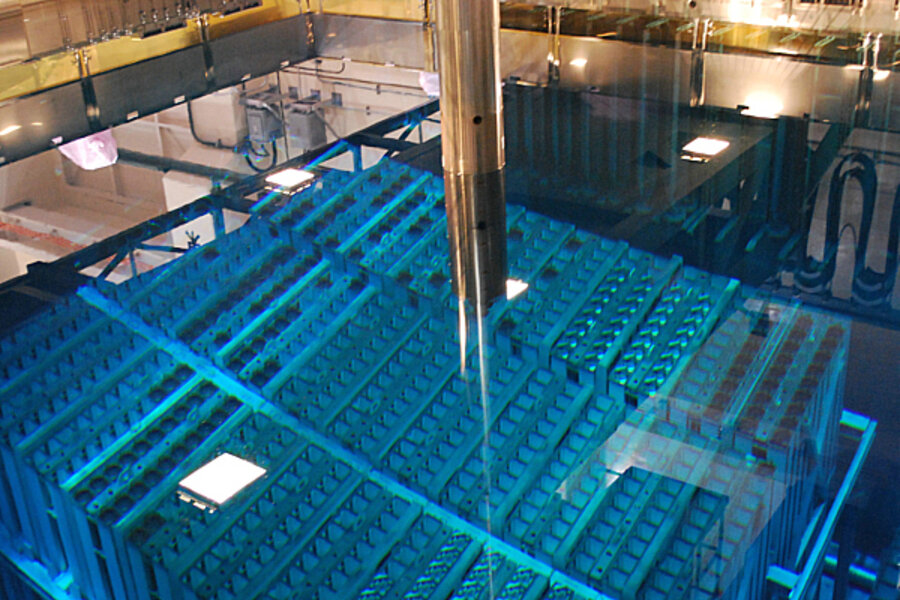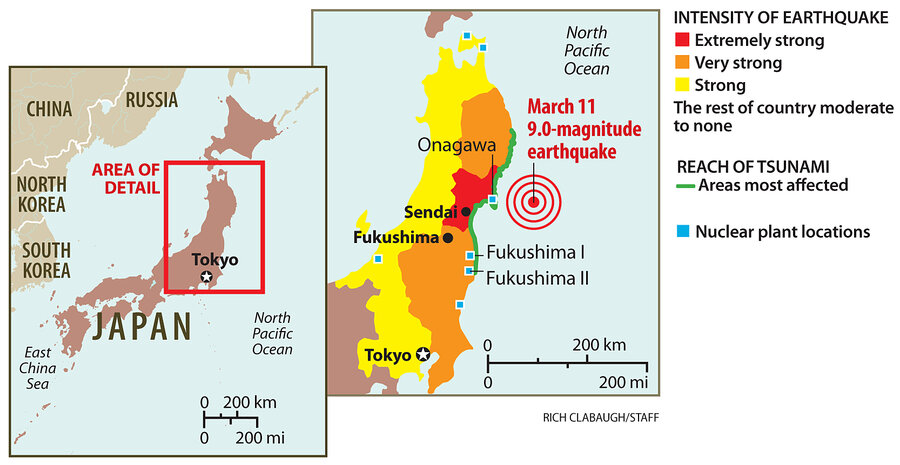Meltdown 101: What are spent-fuel pools and why are they a threat?
Loading...
An explosion and fire at Japan's stricken Fukushima I nuclear power plant has added spent fuel to the roster of crises that workers there are struggling to control.
The explosion, which hit at 6:14 a.m. local time Tuesday, was likely caused by a build-up of hydrogen gas inside No. 4's reactor building, according to Japan's Kyodo News Service, citing officials with the Tokyo Electric Power Company, which operates the facility. Others posit that the fire involved oil and other lubricants in the building.
The explosion blasted a pair of holes, 26 square feet each, in the reactor building wall. Just over two hours later, fire broke out.
The concern: Water levels in the pools holding spent fuel may be boiling off, threatening to expose the fuel. The explosion and fire, as well as an explosion at the No. 2 reactor, reportedly pushed radiation levels at the plant to levels that prevented workers from pouring additional water into the pool.
Spent-fuel pools shielded only by outer reactor building
Spent-fuel pools at the plant sit in the upper reaches of the reactor buildings, near the top of the reactors so cranes have easy access to load and unload fuel.
Most of the radiation shielding at the reactors comes from the thick steel reactor vessel itself, which sits inside a steel-and-concrete containment structure. The upper reaches of reactor buildings represent the weakest barrier in the plant's "defense in depth" approach to keeping dangerous levels of radioactivity out of the environment.
As a result, under the right conditions, the spent-fuel pools at the plant potentially pose as large a threat of environmental contamination – if breached – as the multiply-shielded reactor cores themselves. In particular, two of the reactors – No. 1 and No. 3 – have experienced explosions that blew holes in their roofs and upper levels.
Many nuclear power plants in the United States have a beefier final layer of protection – containment domes of very thick concrete.
How do these 'spent-fuel pools' work?
Each of the six reactor buildings at the Fukushima I plant has its own spent-fuel pool, which holds fuel rods that no longer produce enough energy to be useful, but are still too hot – and too radioactive – for safe disposal.
Ordinarily, pumps circulate water through each spent-fuel pool to carry the heat away. But if the water level in the pool drops too low, the decay heat can begin boiling off the water. If the water level drops enough to expose the metal housing containing the fuel assemblies, the assemblies can heat to the point where the fuel-rod casings catch fire, releasing radioactive gases and particles to find their way into the environment.
Since the magnitude 9.0 earthquake and subsequent tsunami wiped out the sources of emergency power that would have kept cooling pumps operating, the only way to keep cool water in the pools is through fire hoses. Despite workers' best efforts, temperatures Tuesday were rising in the spent-fuel pools of reactors No. 5 and No. 6 at the plant, as well.
Fuel rod assemblies
Each "fuel assembly," roughly 15 feet long, is a unit containing 82 fuel rods full of the reactor's fuel: uranium oxide pellets. During periodic refueling shutdowns, workers typically replace 20 to 30 percent of the fuel assemblies.
Once extracted from the reactor, the used assemblies are housed in close-fitting steel containers that are treated with boron, to ensure they don't resume the chain reactions necessary to generate electricity.
The used assemblies are then submerged in 45 feet of water in a spent-fuel pool. The water acts as a radiation barrier, in addition to serving as a coolant.
Spent fuel releases its most intense heat during the first 100 to 120 days after it is removed from the core, says Glenn Sjoden, a professor of nuclear engineering at Georgia Tech in Atlanta. Indeed, as workers try to cope with three reactor cores and at least four troubled spent-fuel pools, "we're looking at having to manage this heat over the next three months."
After that first few months, a fuel assembly can be removed from the pool for reprocessing, he adds.
At the stricken Fukushima I plant, much of the spent fuel in the six pools had been moved to a reprocessing facility. But No. 4's pool has a full reactor core's worth of spent fuel sitting in it – fuel withdrawn from No. 4's reactor during a routine maintenance outage that began on Nov. 30, 2010.
What did Tuesday's fire and explosion do?
After the explosion and fire Tuesday morning, radiation measurements at the plant's front gate spiked up to 400 millisieverts (mSv) per hour, but that rate came down within hours.
The radiation's most likely sources include radioactive gases that build up inside the fuel rods – a byproduct of splitting uranium atoms while the rods are in the reactors, says Professor Sjoden.
In a boiling-water reactor such as those used at the Fukushima I plant, the gases build to sizable pressures inside the fuel rods, as the reactor uses the fuel. But the gas is held in check by the extraordinary water pressures inside the reactor – at least 1,000 pounds per square inch.
Pressures are far lower in the spent-fuel pool, Sjoden continues, allowing the gases – radioactive krypton 85 and xenon 133 – to percolate out of the fuel assembly, up through the water, and into the interior of the reactor building.
Ordinarily, these gases are vented through a tall stack and its attendant filters. But without power to operate the filtering systems, these non-explosive gases build up, adding to the inventory of radioactivity already released by the explosions in reactors No. 1 and No. 3, and at risk of exposure if the fuel assemblies in the other pools become exposed and begin to burn.
The hole in the roof
The explosions earlier this week that destroyed the roofs of reactor buildings No. 1 and No. 3 may have done more than just remove the major barrier between the pools and the environment, says Harvard University's Hui Zhang, a nuclear physicist and senior researcher at Harvard University's Belfer Center for Science and International Affairs.
He refers to satellite images showing the striking absence of the heavy crane, used for fuel changes and reactor maintenance, from the roof of reactor No. 3. The images suggest that the crane collapsed into the building reactor building – where it may have cracked the spent-fuel pool, increasing the rate at which water could leak out, he says.
Even so, the open roofs in reactors No. 1 and No. 3 could help workers trying to stabilize the pool. Helicopters could transport large volumes of sea water and drop it into the spent-fuel pool through the open roof.
'That list' of plant challenges keeps growing
Even before Tuesday's explosion, plant workers' list of challenges included coolant loss and at least partial exposure of fuel in the reactor cores of units 1, 2, and 3 over the past few days.
"That list only seems to have grown larger" with the addition of the spent-fuel problem, says David Lochbaum, a nuclear engineer who heads the nuclear-safety project at the Union of Concerned Scientists in Washington.
To prevent the water in the nuclear cores or the spent-fuel pools from falling to dangerously low levels, workers must keep adding water, whether via hose or helicopter.
Workers pour in water, the water boils off, the interior temperature rises, workers vent the steam and replace the water that was lost via boiling – and the process begins again.
Even if nothing else untoward happens at the plant, "they're going to have to do this valving and feeding of water over the next several months" to keep the reactors and pools stable, Sjoden says.






